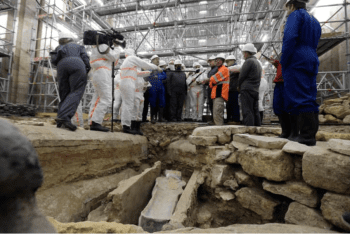Archaeologists have found an ancient lead sarcophagus under Notre Dame cathedral and fragments of a rood screen. These two discoveries offer new insight into the history of the building, which is currently under reconstruction after a devastating fire in 2019.
Notre Dame, which dates back to the 12th century, contracted the excavation works inside the cathedral as a preventive measure before installing scaffolding needed to restore a 100-meter high wooden roof ridge. According to the Culture Ministry, the excavation site is under a stony layer that dates from the 18th century. Still, some lower levels go back as far as the 14th, and some even the early 13th century.
Christophe Besnier from France’s National Archaeological Institute said, “We were able to send a small camera inside which showed cloth remains, organic matter such as hair and plant remains.” The fact that these plants are still there indicates that the contents have been very well preserved.”
Archaeologists believe the lead sarcophagus belonged to a high dignitary and said it could date back to the 14th century, which would be a spectacular find if confirmed. The excavation also revealed a pit immediately below the cathedral floor, which was likely to have been made around 1230, when Notre Dame, one of the oldest examples of French Gothic, was under construction.

As well as the tombs, archaeologists found elements of painted sculptures just beneath the current floor level of the cathedral, identified as parts of the original 13th-century rood screen, an architectural element separating the altar area from the nave. Other features of the structure, destroyed in the early 18th century, were unearthed during Notre Dame’s mid-1800s restoration and are already on display in the Louvre museum.
The Notre Dame fire shocked France, with tearful Parisians and stunned tourists watching in disbelief as the blaze sent the cathedral’s spire crashing down. After the fire, there was debate over how it should be rebuilt. Former Prime Minister Edouard Philippe suggested a modern approach and launched a competition to redesign the spire, although others wanted it to remain traditional.
However, President Macron decided the entire cathedral would be rebuilt exactly as it was, including the spire, which was initially made of wood and fell to the flames in the first few hours of the fire.
“We will rebuild Notre Dame because that’s what the French people are expecting,” a visibly emotional Macron told reporters at the fire site in 2019. “Because that’s what our history is worthy of. Because that’s our deep destiny.” Many works of art and religious relics were moved to safety early in the fire, but others suffered smoke damage. Notre Dame is a historic cathedral that holds a special place in the heart of France. People travel from around the globe to marvel at her beauty. The fire may have devastated part of it, but the cathedral will be rebuilt to its original splendor. When she’s finally rebuilt, France will sing with joy. The Notre Dame cathedral is on track to reopen to the public in 2024.


